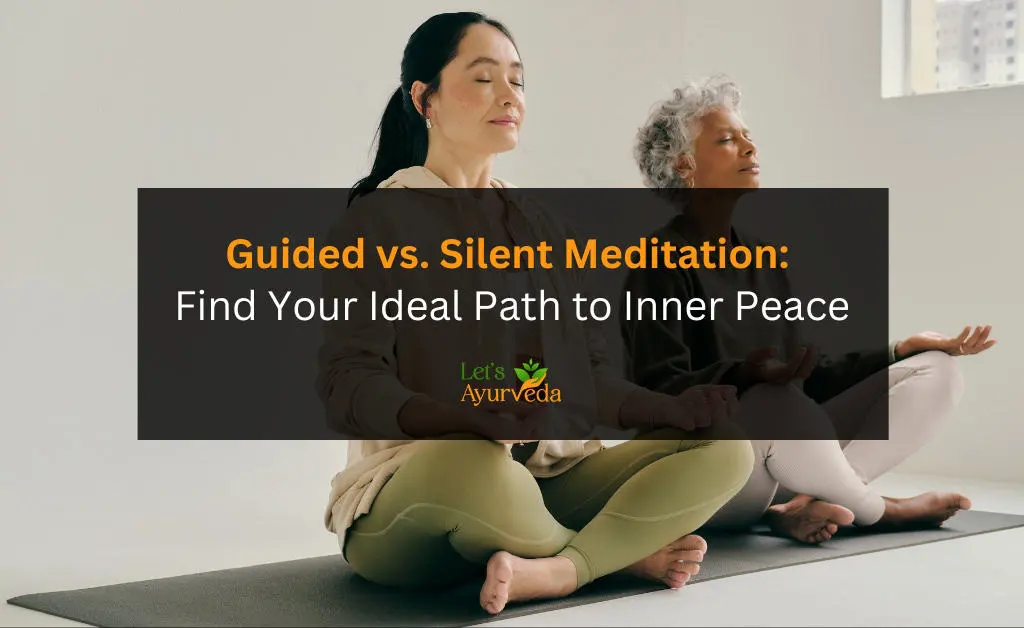Meditation has become a cornerstone of mental wellness, but with so many techniques available, it can be challenging to decide which path suits you best. Two popular types—guided and silent meditation—each offer distinct benefits and experiences. But which one is right for you? In this blog, we’ll dive into the unique qualities of each, look at what science says, and help you make an informed choice.
Understanding the Basics: Guided Meditation vs. Silent Meditation
Before deciding, let’s break down what each form of meditation entails.
-
Guided Meditation
In guided meditation, an instructor (in-person or through a recording) leads you through the practice. They provide verbal cues, imagery, and breathing instructions, making it an ideal choice for beginners who may feel unsure or distracted when trying to meditate on their own. Guided sessions vary in length and focus, from mindfulness and relaxation to visualization and even goal-setting. -
Silent Meditation
Silent meditation, often practiced in mindfulness or Zen traditions, involves sitting quietly and observing your thoughts without guidance. While it may sound straightforward, silent meditation can be challenging because it requires a deep level of focus and discipline. It’s generally recommended for individuals with some experience in meditation, as it can be difficult to calm the mind without external prompts.
Key Differences Between Guided and Silent Meditation
Let’s explore the main distinctions between these two practices to help you find the one that suits your needs and personality.
| Aspect |
Guided Meditation |
Silent Meditation |
|
Ease for Beginners |
Beginner-friendly, as it provides structure |
More challenging, as it requires self-guidance |
|
Level of Focus |
Easier to stay focused with guidance |
High level of self-discipline needed |
|
Goal Specificity |
Often targeted (stress relief, sleep, etc.) |
Can be more open-ended, for general mindfulness |
|
Flexibility |
Can be tailored to various themes |
Typically involves a single method |
|
Tools Needed |
Device for audio/video guidance |
Just a quiet space |
Benefits of Guided Meditation
Guided meditation offers several advantages, especially for those new to meditation. Here are some benefits backed by research:
-
Structured Approach
The structure provided by guided meditation makes it easy to follow, which is why many beginners feel more comfortable with it. Having an instructor’s voice in your ear can keep you focused, making it less likely for your mind to wander. -
Reduced Anxiety and Stress
Research shows that guided meditation can lower stress levels and reduce symptoms of anxiety by helping the body enter a relaxed state. Listening to soothing instructions can slow your heart rate, reduce cortisol levels, and increase feelings of calmness. -
Enhanced Motivation
Guided meditation sessions often include positive affirmations, encouraging you to stay committed to regular practice. A 2021 study published in The Journal of Positive Psychology found that participants who engaged in guided meditation reported higher levels of motivation and well-being than those practicing solo. -
Specific Themes and Goals
From sleep aid to pain relief to focus improvement, guided meditation can be tailored to address specific needs. For instance, sleep-based guided meditations have been shown to improve sleep quality by slowing down the racing thoughts that often accompany insomnia.
Benefits of Silent Meditation
Silent meditation, while potentially more challenging, offers a unique and profound experience. Here are some of its key benefits:
-
Deepened Self-Awareness
Silent meditation encourages introspection, giving you the space to confront and understand your thoughts, emotions, and reactions. Studies suggest that self-guided, silent meditation can promote self-awareness, a key factor in emotional intelligence and resilience. -
Strengthened Mental Discipline
Silent meditation requires a high level of focus, which can strengthen your mental resilience over time. According to research from Harvard Medical School, people who engage in silent meditation show increased gray matter density in areas related to attention and emotional regulation. -
Improved Mindfulness and Presence
Silent meditation can lead to enhanced mindfulness and present-moment awareness, as there is no external guide to direct your thoughts. Practitioners often find themselves more attuned to their surroundings and less reactive to daily stressors. -
Cultivated Inner Peace
Unlike guided meditation, silent meditation lacks any external prompts, allowing practitioners to develop a profound sense of inner calm. As the mind grows quieter over time, this inner silence can lead to a feeling of deep peace and contentment.
Also Read: Sound of Silence Meditation: A Complete Guide
When Guided Meditation Might Be the Better Fit
Guided meditation is typically ideal for those who:
-
Are New to Meditation: The structure and guidance make it less intimidating.
-
Need Help Staying Focused: The instructor’s voice provides a point of concentration.
-
Have Specific Goals: If you’re looking to target a particular area—like stress, sleep, or confidence—a guided meditation that’s tailored to that goal may work best.
-
Prefer a Soothing Environment: Guided meditations often incorporate calming music and nature sounds, which can help set the mood for relaxation.
When Silent Meditation Might Be the Better Fit
Silent meditation may be a better option if you:
-
Have Experience with Meditation: This practice often requires a higher level of discipline and focus.
-
Seek Deep Introspection: Silent meditation provides a space for deeper self-exploration.
-
Want to Build Mental Resilience: The challenge of maintaining focus on your own can strengthen your mental fortitude.
-
Prefer Minimal Distractions: Without external guidance, you can experience pure, uninterrupted silence, which can be deeply peaceful.
Science-Backed Comparison: What Research Says
Meditation has become a well-researched field, and studies comparing guided and silent practices reveal valuable insights:
-
Cognitive Benefits: Both forms improve cognitive functions, but silent meditation has shown slightly better outcomes in improving sustained attention and memory.
-
Emotional Well-being: Guided meditation can be more effective in reducing symptoms of anxiety, stress, and depression, especially in beginners.
-
Physical Health: A study by the National Center for Complementary and Integrative Health found that both forms of meditation help lower blood pressure and improve heart health by inducing relaxation and reducing stress hormones like cortisol.
Choosing the Right Practice: A Practical Guide
To decide which form of meditation is best for you, consider trying both and observing how they make you feel. Here’s a simple three-step approach to guide you:
-
Start with Guided Meditation
If you’re new to meditation or find it hard to quiet your mind, try starting with guided sessions. Even a short 5-10 minute guided session can help you get comfortable with the practice. -
Experiment with Silent Sessions
Once you feel more grounded, introduce silent meditation into your routine. Start with shorter periods, maybe 5 minutes, and gradually increase as your focus improves. -
Assess and Mix
Many meditators find that a mix of both guided and silent meditation works best. For instance, you might start with a guided session to ease into relaxation, then transition to silence for deeper introspection.
Conclusion: Finding Your Meditation Path
Guided and silent meditation both offer unique pathways to mental clarity, emotional balance, and physical well-being. Guided meditation provides structured support, making it perfect for beginners and goal-oriented practitioners. In contrast, silent meditation offers a more independent journey into self-awareness and mindfulness, ideal for those seeking a deeper, introspective practice.
Remember, there’s no “one-size-fits-all” approach in meditation. The best practice is the one you feel connected to and can maintain consistently. So, take some time, try both, and discover which type of meditation resonates with you. Whether guided or silent, embracing either can be a transformative step toward a more mindful life.






